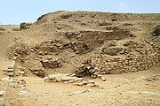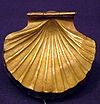
Sekhemkhet
Encyclopedia
Sekhemkhet was a Pharaoh
in Egypt
during the Third dynasty
. According to the Manetho
nian tradition, a king known as Tyris (which may be compared to the Turin Canon's "Djoser-ti") reigned for a relatively brief period of seven years, and modern scholars believe Djoserty and Sekhemkhet are the same person. While the Turin Canon gives Sekhemkhet a reign of 6 years.http://www.narmer.pl/dyn/03en.htm, Toby Wilkinson
's reconstruction of the Dynasty 5 Palermo Stone
Annal document assigns a reign of 7 years to this king based on the number of year register preserved for him in Cairo Fragment One, register
V. Wilkinson states that "this figure is fairly certain, since the [king's] titulary begins immediately after the dividing line marking the change of reign." Hence, the Manethonian tradition appears to be correct. His reign is thought to have been from about 2648 BC until 2640 BC. Sekhemkhet's name means "Powerful in Body."
Sekhemkhet's wife may have been Djeseretnebti
, but this name appears without any queen's title, and Egyptologists dispute the true meaning and reading of this name. The name has alternatively been read as Djeser-Ti and identified with the cartouche-name of the pharaoh Djeser-Teti of the Abydos King List
.
, Sekhemkhet's name was unknown until 1951, when the leveled foundation and vestiges of an unfinished Step Pyramid
were discovered at Saqqara
by Zakaria Goneim
. Only the lowest step of the pyramid had been constructed at the time of his death. Jar seals found on the site were found inscribed with this king's name. From its design and an inscription from his pyramid at Saqqara, it is thought that Djoser's famous architect Imhotep
had a hand in the design of this pyramid. Imhotep's name appears in a graffito on the enclosure wall surrounding Sekhemkhet's unfinished step-pyramid which suggests that this official outlived Djoser and went on to serve under king Sekhemkhet.Archaeologists believe that Sekhemket's pyramid
would have been larger than Djoser
's had it been completed. Today the site, which lies southwest of Djoser's complex, is mostly concealed beneath sand dunes and is known as the Buried Pyramid
.
A shell shaped container made of gold was found in Sekhemkhet's unfinished pyramid by an Egyptian Antiquities Service excavation team in 1950. The object has a length of 5.3 centimetres and is currently located in Room 4 of the Cairo Museum.

Pharaoh
Pharaoh is a title used in many modern discussions of the ancient Egyptian rulers of all periods. The title originates in the term "pr-aa" which means "great house" and describes the royal palace...
in Egypt
Egypt
Egypt , officially the Arab Republic of Egypt, Arabic: , is a country mainly in North Africa, with the Sinai Peninsula forming a land bridge in Southwest Asia. Egypt is thus a transcontinental country, and a major power in Africa, the Mediterranean Basin, the Middle East and the Muslim world...
during the Third dynasty
Third dynasty of Egypt
For the Sumerian Renaissance, see Third Dynasty of Ur.The Third Dynasty of ancient Egypt is the first dynasty of the Old Kingdom. Other dynasties of the Old Kingdom include the Fourth, Fifth and Sixth...
. According to the Manetho
Manetho
Manetho was an Egyptian historian and priest from Sebennytos who lived during the Ptolemaic era, approximately during the 3rd century BC. Manetho wrote the Aegyptiaca...
nian tradition, a king known as Tyris (which may be compared to the Turin Canon's "Djoser-ti") reigned for a relatively brief period of seven years, and modern scholars believe Djoserty and Sekhemkhet are the same person. While the Turin Canon gives Sekhemkhet a reign of 6 years.http://www.narmer.pl/dyn/03en.htm, Toby Wilkinson
Toby Wilkinson
Toby A. H. Wilkinson is an English Egyptologist. He is a Fellow of Clare College, Cambridge, and an Honorary Research Fellow in the Department of Archaeology, University of Durham.-Selected works:...
's reconstruction of the Dynasty 5 Palermo Stone
Palermo stone
The Palermo Stone is a large fragment of a stele known as the Royal Annals of the Old Kingdom of Ancient Egypt. It contains records of the kings of Egypt from the first dynasty through the fifth dynasty....
Annal document assigns a reign of 7 years to this king based on the number of year register preserved for him in Cairo Fragment One, register
Register (sculpture)
In art and archaeology, a register is a vertical level in a work that consists of several levels, especially where the levels are clearly separated by lines; modern comic books typically use similar conventions...
V. Wilkinson states that "this figure is fairly certain, since the [king's] titulary begins immediately after the dividing line marking the change of reign." Hence, the Manethonian tradition appears to be correct. His reign is thought to have been from about 2648 BC until 2640 BC. Sekhemkhet's name means "Powerful in Body."
Sekhemkhet's wife may have been Djeseretnebti
Djeseretnebti
Djeseretnebti is possibly the name of an Ancient Egyptian queen. Since this name appears without any queen's title, Egyptologists dispute the true meaning and reading of this name.- Evidence :...
, but this name appears without any queen's title, and Egyptologists dispute the true meaning and reading of this name. The name has alternatively been read as Djeser-Ti and identified with the cartouche-name of the pharaoh Djeser-Teti of the Abydos King List
Abydos King List
The Abydos King List, also called the Abydos Table is a list of the names of seventy-six kings and pharaohs of Ancient Egypt, found on the walls of the Temple of Seti I at Abydos, Egypt. It consists of three rows of thirty-eight cartouches on each row...
.
Pyramid
While there was a known successor to DjoserDjoser
Netjerikhet or Djoser is the best-known pharaoh of the Third dynasty of Egypt. He commissioned his official, Imhotep, to build the first of the pyramids, a step pyramid for him at Saqqara...
, Sekhemkhet's name was unknown until 1951, when the leveled foundation and vestiges of an unfinished Step Pyramid
Step pyramid
Step pyramids are structures which characterized several cultures throughout history, in several locations throughout the world. These pyramids typically are large and made of several layers of stone...
were discovered at Saqqara
Saqqara
Saqqara is a vast, ancient burial ground in Egypt, serving as the necropolis for the Ancient Egyptian capital, Memphis. Saqqara features numerous pyramids, including the world famous Step pyramid of Djoser, sometimes referred to as the Step Tomb due to its rectangular base, as well as a number of...
by Zakaria Goneim
Zakaria Goneim
Muhammed Zakaria Goneim was an Egyptian archaeologist, known for his discoveries in and around Saqqara. He is best known for discovering the Step pyramid of Sekhemkhet....
. Only the lowest step of the pyramid had been constructed at the time of his death. Jar seals found on the site were found inscribed with this king's name. From its design and an inscription from his pyramid at Saqqara, it is thought that Djoser's famous architect Imhotep
Imhotep
Imhotep , fl. 27th century BC was an Egyptian polymath, who served under the Third Dynasty king Djoser as chancellor to the pharaoh and high priest of the sun god Ra at Heliopolis...
had a hand in the design of this pyramid. Imhotep's name appears in a graffito on the enclosure wall surrounding Sekhemkhet's unfinished step-pyramid which suggests that this official outlived Djoser and went on to serve under king Sekhemkhet.Archaeologists believe that Sekhemket's pyramid
Egyptian pyramids
The Egyptian pyramids are ancient pyramid-shaped masonry structures located in Egypt.There are 138 pyramids discovered in Egypt as of 2008. Most were built as tombs for the country's Pharaohs and their consorts during the Old and Middle Kingdom periods.The earliest known Egyptian pyramids are found...
would have been larger than Djoser
Djoser
Netjerikhet or Djoser is the best-known pharaoh of the Third dynasty of Egypt. He commissioned his official, Imhotep, to build the first of the pyramids, a step pyramid for him at Saqqara...
's had it been completed. Today the site, which lies southwest of Djoser's complex, is mostly concealed beneath sand dunes and is known as the Buried Pyramid
Buried Pyramid
The ' is the common name for the funerary complex of pharaoh Sekhemkhet, and is a collection of monuments dating from the Old Kingdom of ancient Egypt. It is located in the Saqqara necropolis, close to modern Memphis....
.
A shell shaped container made of gold was found in Sekhemkhet's unfinished pyramid by an Egyptian Antiquities Service excavation team in 1950. The object has a length of 5.3 centimetres and is currently located in Room 4 of the Cairo Museum.


